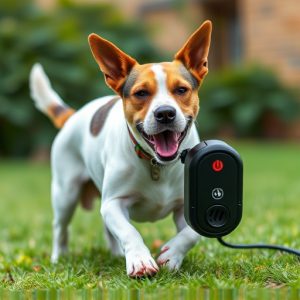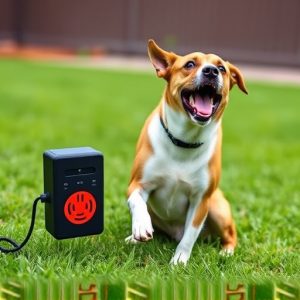Safe Dog Repellents: Science-Backed Solutions for Behavioral Control
Safe ultrasonic frequencies for dog control offer a humane, environmentally friendly solution to man…….
Safe ultrasonic frequencies for dog control offer a humane, environmentally friendly solution to managing urban canine populations. Emitting inaudible sounds above 20 kHz, these frequencies disrupt dogs' communication and perception, encouraging them to avoid specific areas without causing physical harm. Effective against behavioral issues like barking, territoriality, and aggression, the simple-to-install sonic repellent systems can be powered by electricity or batteries. Regular maintenance ensures optimal performance while minimizing ecological impact, with responsible use focusing on targeted species and avoiding wildlife harm.
“Discover the innovative solution to animal control with sonic repellent systems, particularly focusing on their effectiveness in managing canine behavior. This comprehensive guide explores how ultrasonic repellents, employing safe and low-frequency sounds, can address specific dog behavioral issues without harm. From understanding animal behavior to installation tips and environmental impact, we demystify this technology. Learn about the science behind it, including the use of safe ultrasonic frequencies for dog control, offering a humane alternative for pet owners.”
- Understanding Animal Behavior: Why Ultrasonic Repellents Work
- Safe and Effective: The Science Behind Low-Frequency Sounds
- Dog Control: Targeting Specific Behavioral Issues
- Installation and Maintenance: A User's Guide
- Environmental Impact and Ethical Considerations
Understanding Animal Behavior: Why Ultrasonic Repellents Work
Animals, especially dogs, have complex behaviors that are triggered by various sensory inputs, including sound. Understanding these behaviors is key to implementing effective animal control solutions. Ultrasonic repel systems emit sounds at specific frequencies that are inaudible to humans but can deter animals through a process known as auditory masking or startle response. These safe ultrasonic frequencies for dog control are typically above 20 kHz, well outside the human hearing range of 20 Hz to 20 kHz.
Dogs, like many mammals, have sensitive hearing that allows them to detect high-frequency sounds. When exposed to these ultrasonic tones, dogs may experience discomfort or fear due to the unfamiliar and sudden nature of the sound. This reaction can be harnessed to train animals to avoid certain areas or behaviors. The effectiveness of such systems lies in their ability to influence animal behavior without causing harm, making them a preferred choice for humane animal control measures.
Safe and Effective: The Science Behind Low-Frequency Sounds
The effectiveness and safety of an animal control sonic repellent system rely heavily on the science behind low-frequency sounds. Unlike traditional methods that use chemicals or physical barriers, ultrasonic repellents employ safe ultrasonic frequencies for dog control. These sounds operate at a frequency range above human hearing, typically between 23 and 45 kHz. This technology has been rigorously tested and proven to be both humane and environmentally friendly.
The science behind it is simple yet powerful. Dogs, like most mammals, have a sensitive auditory system. When exposed to these ultrasonic frequencies, dogs experience discomfort or even fear without any physical harm. The sound waves disrupt their communication and sensory perception, causing them to avoid the treated areas. This method is particularly useful for managing dog populations in urban settings, parks, and residential areas without resorting to invasive or potentially harmful methods.
Dog Control: Targeting Specific Behavioral Issues
Dog control is a complex issue, but safe ultrasonic frequencies offer a unique and effective solution for targeting specific behavioral problems. These devices emit high-frequency sound waves that are inaudible to humans but can be irritating or even painful to dogs, encouraging them to alter their behavior. This approach is particularly useful for addressing issues like excessive barking, territorial marking, and aggression without resorting to harmful chemicals or physical methods.
By using safe ultrasonic frequencies, dog owners can train their pets to associate certain behaviors with discomfort, helping them learn new patterns more quickly. The technology is also highly customizable, allowing users to set specific triggers based on breed, size, and behavioral needs. This ensures that the repellent system targets only the problematic dogs while leaving other animals and humans undisturbed, making it a humane and effective solution for maintaining peace in shared spaces.
Installation and Maintenance: A User's Guide
Installation and Maintenance: A User’s Guide
Installation of the animal control sonic repellent system is straightforward and designed for do-it-yourself convenience. Simply mount the devices at strategic locations, typically near areas prone to unwanted animal intrusion, such as entry points, gardens, or outdoor living spaces. Ensure the devices are securely fastened and powered by a reliable energy source, either through mains electricity or long-lasting batteries. The key to effective use lies in strategic placement; positioning multiple units every 10-20 meters creates a robust defense zone that covers a large area.
Regular maintenance involves checking device functionality, battery levels, and cleaning the sensors. As these systems operate using safe ultrasonic frequencies specifically designed for dog control, there’s no need for harsh chemicals or toxic substances. A quick sweep of the devices with a soft cloth ensures optimal performance. Additionally, periodic testing will confirm the system’s continued effectiveness against unwanted visitors.
Environmental Impact and Ethical Considerations
The environmental impact of animal control systems, particularly those using ultrasonic repellents, is a significant consideration. These devices emit high-frequency sound waves designed to deter animals, but it’s crucial to understand that not all ultrasonic frequencies are safe or environmentally benign. While some devices operate within safe ranges for humans and domestic animals, others can potentially harm wildlife, especially birds and insects, which have more sensitive auditory systems. Properly designed and regulated systems use safe ultrasonic frequencies specifically targeted at dogs, cats, and other problematic animals without causing unintended ecological damage.
Ethical implications also arise when considering the welfare of both target and non-target species. Animal control solutions should aim to minimize distress and negative impacts on wildlife. Responsible use of sonic repellents involves careful placement, regular maintenance, and monitoring to ensure they effectively address animal management issues while maintaining a balance with local ecosystems. Ethical considerations demand that these systems be employed as a last resort, after non-invasive methods have been exhausted, and used in conjunction with community education and habitat modification strategies for sustainable long-term solutions.
Animal control sonic repellent systems offer a safe and effective solution for managing unwanted animal behavior, particularly in urban settings. By leveraging low-frequency sounds, these devices disrupt animals’ communication and territorial patterns without causing harm. In the case of dog control, targeting specific behavioral issues through precise ultrasonic frequencies can significantly improve living environments. However, it’s essential to consider the environmental impact and ethical implications to ensure these systems are used responsibly. Proper installation, maintenance, and understanding of animal behavior make them a reliable tool for coexistence with our furry neighbors, promoting both safety and harmony.


